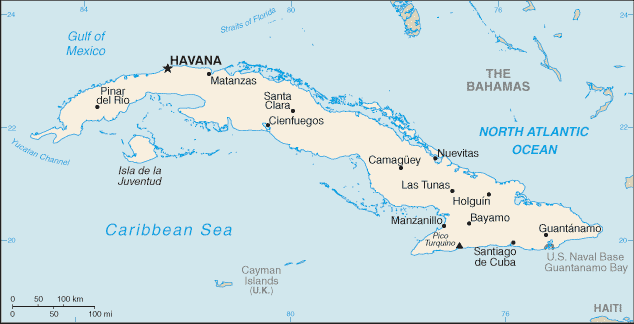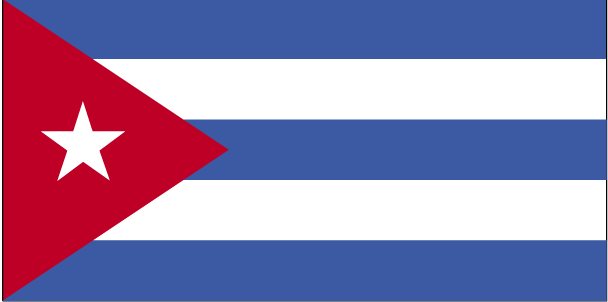Official Name: Republic of Cuba
National Symbol: The Tocororo (Cuban trogon)
Internet Domain: .ec
International Dialing Code: +53
| Location and Size | Comparative Economic Indicators |
| Government | Risk Assessment |
| Legal System | Business Climate |
| Interesting Facts | Business Protocol |
| Economy |
Cuba is one large island and several small ones situated on the northern rim of the Caribbean Sea, about 100 miles south of Florida. The area occupied by Cuba is slightly smaller that the state of Pennsylvania.
Government
Cuba’s government is a Communist state with 15 provinces.
Branches:
- Executive: Chief of State and Head of Government: President of the Council of State and President of the Council of Ministers, Miguel DIAZ-CANEL Bermudez (since 19 April, 2018), First Vice President of the Council of the State and First Vice President of the Council on Minsters Salvador Antonio VALDES Messa (since 19 April, 2018). The President is both chief of state and head of government.
- Legislative: National Assembly of People’s Power. The number of seats is based on populations and currently exceeds 600; members are elected directly approved by special candidacy commissions to serve five-year terms.
- Judicial: People’s Supreme Court
Legal System
Civil law system is based on Spanish civil code and were influenced by the principles of Marxism-Leninism after that philosophy became the guiding force of government.
Interesting Facts About Cuba
- Cuba has one of the lowest birthrates in all of the Western Hemisphere.
- Cuba is the 17th largest island in the world.
- Christmas did not become an official holiday in Cuba until 1997.
- Bacardi rum was originally manufactured in Cuba before moving to Puerto Rico.
- Baseball is the favorite sport in Cuba.
Economy
In December 2014, United States President, Barack Obama, used negotiations over a couple of imprisoned Americans to refashion the entire U.S.-Cuba relationship. Lawmakers are currently writing legislation to reopen the embassy, relax trade and travel restrictions, and improve communication systems. Currently only some US businesses are doing business with Cuba after this move.
The administration hopes the new approach will deepen ties between ordinary Cubans and Americans rather than enrich the Cuban state, which directly controls much of the economy. Business groups, meanwhile, hope giving Cubans a taste of American money will encourage Havana to open up the economy further, potentially allowing significant investment in the future.
Recently, Netflix Inc. began offering their streaming video service to Cuba, which was the first large US based business to begin dealing with the country. Also, the Turner Broadcasting Company’s late night talk show Conan recently filmed a week’s worth of episodes from Cuba.
More than a half century ago Fidel Castro took power in Havana. In the midst of the Cold War the Kennedy administration feared that Cuba would serve as an advanced base for the Soviet Union. Having tried and failed to overthrow the regime militarily, Washington saw an economic embargo as the next best option.
Leading Markets (2017): Venezuela 17.8%, Spain 12.2%, Russia 7.9%, Lebanon 6.1%, Indonesia 4.5%, Germany 4.3%
Leading Exports – Commodities: Petroleum, bananas, cut flowers, shrimp, cacao, coffee, wood, fish
Leading Suppliers (2017): China 22%, Spain 14%, Russia 5%, Brazil 5%, Mexico 4.9%, Italy 4.8%, US 4.5%
Leading Imports – Commodities: Petroleum, food, machinery and equipment, chemicals
Top Industries: Petroleum, nickel, cobalt, pharmaceuticals, tobacco, construction, steel, cement, sugar
Top Agricultural Products: Sugar, tobacco, citrus, coffee, rice, potatoes, beans, livestock
Comparative Economic Indicators ” 2018
| Cuba | Venezuela | Argentina | Bolivia | Haiti | Ecuador | |
| Population* (millions) | 11.1 | 31.6 | 44.6 | 11.3 | 10.7 | 16.4 |
| Population growth rate (%) | -0.27 | 1.21 | 0.89 | 1.48 | 1.31 | 1.25 |
|
Age Structure (%)
(15 to 64 years old)
|
68.3 | 65.5 | 63.7 | 63.23 | 63.53 | 18.19 |
|
Age Structure (%)
(65+ years old)
|
15.2 | 7.3 | 11.7 | 5.43 | 4.21 | 7.67 |
| Literacy (%) | 99.8 | 97.1 | 99.1 | 92.5 | 60.7 | 94.4 |
| Unemployment rate (%) | 2.6 | 27.1 | 8.4 | 4.0 | 40.6 | 4.6 |
| Inflation (%) | 5.5 | 1,087.5 | 25.7 | 2.8 | 14.7 | 0.4 |
| Population below poverty line (%) | n/a | 19.7 | 25..7 | 38.6 | 58.5 | 21.5 |
| GDP** (USD billions) | 137.0 | 381.6 | 922.1 | 93.72 | 19.97 | 193.0 |
| GDP real growth rate (%) | 1.6 | -14.0 | 2.9 | 4.2 | 1.2 | 2.4 |
| GDP per capita** (USD) | 12,300.0 | 12,500.0 | 20,900.0 | 7,600.0 | 1,800.0 | 11,500.0 |
| Public debt (% of GDP) | 47.7 | 38.9 | 57.6 | 49.0 | 31.1 | 45.4 |
| Industrial production growth rate (%) | -1.2 | -2.0 | 2.7 | 2.2 | 0.9 | -0.6 |
| Exports (USD billions) | 2.6 | 32.0 | 58.4 | 7.7 | 0.980 | 19.6 |
| Imports (USD billions) | 11.0 | 11.0 | 63.7 | 8.6 | 3.6 | 19.3 |
| Reserves of foreign exchange and gold (USD billions) | 11.3 | 9.6 | 55.3 | 10.2 | 2.3 | 2.3 |
| Currency | Cuban Peso (CUP) |
Bolivar (VES) |
Peso (CLP) |
Peso (COP) |
Nuevo Sol (PEN) |
Dollar (USD) |
| Exchange rates (per USD) 09/24/2019 | 1.00 | 19,887.00 | 721.50 | 3,439.45 | 3.35 | n/a |
| Exchange rates (per EUR) 09/24/2019 | 1.10 | 21,864.76 | 793.25 | 3,782.98 | 3.68 | 1.10 |
| Rating in 2018 Corruption Perceptions Index*** | 4.7 | 1.8 | 4.0 | 2.9 | 2.0 | 3.4 |
| Rating in 2019 Index of Economic Freedom*** | 27.8 | 25.9 | 52.2 | 42.3 | 52.7 | 46.9 |
* July, 2017 estimates
** PPP ” Purchasing Power Parity
*** 2018 Corruption Index: 10=Very Clean; 0=Highly Corrupt
**** 2019 Index of Economic Freedom: 100-80=Free; 49.9-0-Repressed
Economic Data from CIA World Factbook
2018 Corruption Perceptions Index, Transparency International
2019 Index of Economic Freedom, Heritage Foundation
Risk Assessment
Coface Country Rating: E — A very uncertain political and economic outlook and a business environment with many troublesome weaknesses can have a significant impact on corporate payment behavior. Corporate default probability is high.
Coface Business Climate Rating: E — see above.
Credendo Political Risk Rating: 7 — Highest risk
Credendo Commercial Risk Rating: C — High risk
Business Climate
Private investment has shrunk due to costly regulations and uncertainty. The trade regime has become more restrictive, reducing competition and eroding productivity. Ecuador’s underdeveloped and state-controlled financial sector limits access to credit and the overall investment climate is becoming increasingly risky.
Economic Freedom Cuba’s economic freedom score is 27.8, making its economy one of the world’s least free in the 2015 Index of Economic Freedom. Its overall score is 0.9 point higher than last year, with a slight deterioration in monetary freedom outweighed by improvements in three of the 10 economic freedoms, including trade freedom, and freedom and corruption. Cuba is ranked least free of 20 countries in the South and Central American/Caribbean region, and its overall score is significantly lower that the regional average.
Market Access: Cuba’s average tariff rate is 8.1 percent. The country’s centrally planned economy is a barrier to the free flow of international trade and investment. The financial sector is tightly controlled by the state. Credit is not allocated on market terms, and capital markets remain underdeveloped.
Regulatory System: Private entrepreneurship exists only on a very small scale. The inconsistent and non-transparent application of regulations impedes the creation of new businesses. The rigid, state-controlled labor market has helped create a large informal economy. The government tried to contain inflation directly by using price controls and regulating the limited areas of free-market activity and indirectly by controlling monetary growth.
Intellectual Property Rights: Cuba has passes advanced intellectual property protection legislation in line with its active participation in the international arena. As a result, trademarks registered in the United States enjoy certain protection in Cuba under its current trademark laws and the international treaties to which Cuba and the United States are both signatories.
Corruption: The state ownership has contributed to rampant corruption. The book Corruption in Cuba says that when given the opportunity, few citizens hesitate to steal from the government. Since the bulk of the productive resources are owned and managed by the state and the majority of Cubans work for state-owned enterprises, petty crimes are widespread.
Business Protocol in Cuba
- Men typically wear long-sleeved shirts to meetings, but a tie and jacket are not necessary. Women wear dress pants or dresses. Short sleeves are considered to be inappropriate at meetings.
- Avoid conversations about politics with clients, although not every citizen is fond of the Communist Party, Cubans are loyal to their country.
- Business cards are exchanged during the initial introductions. Although most business executives speak English, it is a good idea to have one side of your business card translated into Spanish.
- Most business people speak English, but some knowledge of the Spanish language is helpful. It is common to be interrupted during conversations, and this practice is not considered rude in Cuba.
- Most business meals will occur over lunch, because dinner is considered to be more formal in Cuba, and business will not be discussed. It is common for men to stand when women enter the room or leave the table.
For more information on business protocol in Cuba, visit: Lonely Planet
**********
Subscribe to the Credit-to-Cash Advisor
Monthly e-Newsletter — It’s Free
This information is provided by ABC-Amega Inc. Providing international receivable management and debt collection services for exporters to more than 200 countries. For further information, contact [email protected].
This report represents a compilation of information from a wide variety of reputable sources.
Comparative Economic Indicators: CIA World Factbook
Risk Assessment information: Coface Country Rating, Credendo and Political Risk Insurance Center.
Exchange Rates: OANDA.com The Currency Site.

